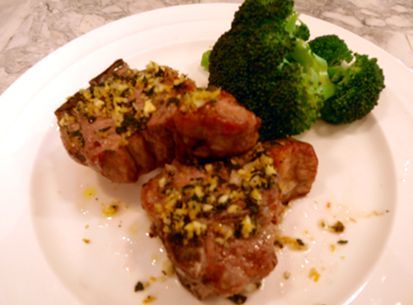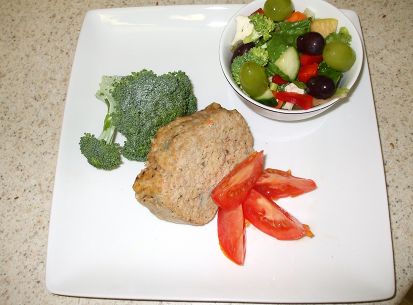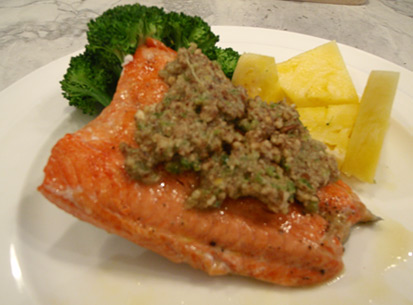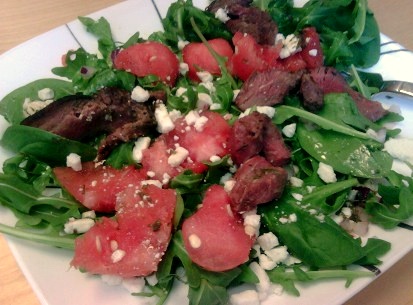Lamb Chops with Lemon-Mint Gremolata
Simple Food Made Glamourous (Rodale, 2010) by Donatella
Ingredients:
8 lamb rib chops
2 lemons, zested
1 large shallot, finely chopped
2 garlic cloves, finely chopped
1 Tbsp finely chopped fresh mint
1 tsp extra virgin olive oil
Lemon olive oil (optional)
Brush lamb chops with olive oil; add salt and peeper to taste. Set aside at room temperature for 20 minutes to 1 hour.
Meanwhile, make the lemon-mint gremolata by mixing the lemon zest, shallot, garlic, and mint in a small bowl; set aside
Preheat the broiler with the oven rack 5 to 6 inches from the heat source. Place the chops on a rimmed baking sheet or broiler pan outfitted with a rack. When the broiler is very hot, broil the chops for 4 minutes on each side. Turn off the broiler, but leave the chops in the oven with the door closed. Let the chops rest for 10 minutes for medium-rare, or 15 minutes for medium.
Arrange two chops on each plate and coat with gremolata. Top chops with a drizzle of lemon olive oil, if desired.
Makes 4 servings. Per serving: 210 calories, 9g fat, 2g carbs, 28g protein.
Gramma’s Chicken Meatloaf
By Gail Tapscott
Preheat oven to 350 F
Ingredients:
2 lbs ground chicken ( Organic)
1 Egg
1/2 tsp of each:
Sage
Rosemary
Basil
Sea Salt
1/4 tsp Black pepper
2 tsp prepared spicy mustard
Fine chopped :
1 carrot
1 small onion
1 stalk celery
Directions:
Mix all ingredients together
Press into a loaf pan
Bake in oven for 1 Hour
Remove from oven,
Slice into 6 slices & enjoy
Fish Broth/Stock
3 or 4 whole carcasses, including heads, of non-oily fish such as sole, turbot, rockfish or snapper
2 tablespoons butter
2 onions, coarsely chopped
1 carrot, coarsely chopped
several sprigs fresh thyme
several sprigs parsley
1 bay leaf
1/2 cup dry white wine or vermouth
1/4 cup vinegar
about 3 quarts cold filtered water
Ideally, fish stock is made from the bones of sole or turbot. In Europe, you can buy these fish on the bone. The fish monger skins and filets the fish for you, giving you the filets for your evening meal and the bones for making the stock and final sauce. Unfortunately, in America sole arrives at the fish market preboned. But snapper, rock fish and other non-oily fish work equally well; and a good fish merchant will save the carcasses for you if you ask him. As he normally throws these carcasses away, he shouldn’t charge you for them. Be sure to take the heads as well as the body—these are especially rich in iodine and fat-soluble vitamins. Classic cooking texts advise against using oily fish such as salmon for making broth, probably because highly unsaturated fish oils become rancid during the long cooking process.
Melt butter in a large stainless steel pot. Add the vegetables and cook very gently, about 1/2 hour, until they are soft. Add wine and bring to a boil. Add the fish carcasses and cover with cold, filtered water. Add vinegar. Bring to a boil and skim off the scum and impurities as they rise to the top. Tie herbs together and add to the pot. Reduce heat, cover and simmer for at least 4 hours or as long as 24 hours. Remove carcasses with tongs or a slotted spoon and strain the liquid into pint-sized storage containers for refrigerator or freezer. Chill well in the refrigerator and remove any congealed fat before transferring to the freezer for long-term storage.
*** Source: http://westonaprice.org/
Beef Broth/Stock
About 4 pounds beef marrow and knuckle bones
1 calves foot, cut into pieces (optional)
3 pounds meaty rib or neck bones
4 or more quarts cold filtered water
1/2 cup vinegar
3 onions, coarsely chopped
3 carrots, coarsely chopped
3 celery stalks, coarsely chopped
several sprigs of fresh thyme, tied together
1 teaspoon dried green peppercorns, crushed
l bunch parsley
Place the knuckle and marrow bones and optional calves foot in a very large pot with vinegar and cover with water. Let stand for one hour. Meanwhile, place the meaty bones in a roasting pan and brown at 350 degrees in the oven. When well browned, add to the pot along with the vegetables. Pour the fat out of the roasting pan, add cold water to the pan, set over a high flame and bring to a boil, stirring with a wooden spoon to loosen up coagulated juices. Add this liquid to the pot. Add additional water, if necessary, to cover the bones; but the liquid should come no higher than within one inch of the rim of the pot, as the volume expands slightly during cooking. Bring to a boil. A large amount of scum will come to the top, and it is important to remove this with a spoon. After you have skimmed, reduce heat and add the thyme and crushed peppercorns.
Simmer stock for at least 12 and as long as 72 hours. Just before finishing, add the parsley and simmer another 10 minutes. You will now have a pot of rather repulsive-looking brown liquid containing globs of gelatinous and fatty material. It doesn’t even smell particularly good. But don’t despair. After straining you will have a delicious and nourishing clear broth that forms the basis for many other recipes in this book.
Remove bones with tongs or a slotted spoon. Strain the stock into a large bowl. Let cool in the refrigerator and remove the congealed fat that rises to the top. Transfer to smaller containers and to the freezer for long-term storage.
*** Source: http://westonaprice.org/








